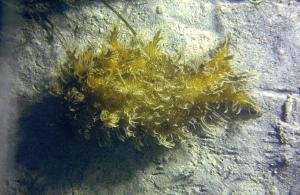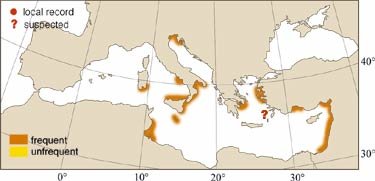
|
Relevant Synonyms
Misidentification
|
|
| photo : L. Mizzan |
|
SHORT
DESCRIPTION
color :
dull brown or greenish brown, with reticulate markins, black spots and clear, brighter green areas, each with a peacok-blue ocellus (sometimes absent). Inner edges of the parapodia, mantle cavity and pedal sole paler.
common size :
usually from 50 to 100 mm, up to 150 mm. |
DISTINGUISHING CHARACTERISTICS
BIOLOGY / ECOLOGY
habitat :
in the Mediterranean usually found in soft bottoms covered by Caulerpa prolifera or by Cymodocea nodosa and Zostera noltii. |
|
1st
Mediterranean record
|

|
|
DISTRIBUTION
|
ESTABLISHMENT SUCCESS
speculated reasons for success :
|
|
|
MODE OF
INTRODUCTION |
IMPORTANCE TO
HUMANS |
|
KEY
REFERENCES
|
|
|
 Bursatella savignana Aouduin, 1826
Bursatella savignana Aouduin, 1826